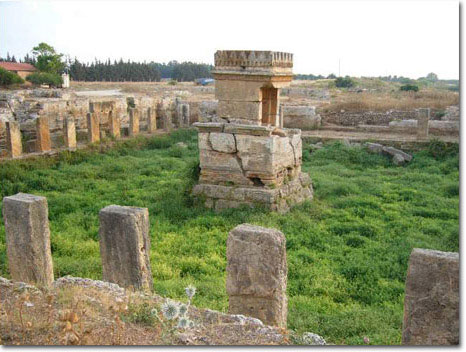|
 7 km
south of Tartous; Amrit was a Phoenician religious center, heavily
influenced in its architectural style by the Achaemenid Persians. It is
the only extant site in Syria whose remains, though fragmentary, convey
this mixture of civilizations, reflecting the ability of the
Phoenicians to absorb and syncretise outside influences. It was also
the continental port for the Phoenician settlement on Arwad, the island
2.5 km to the west. 7 km
south of Tartous; Amrit was a Phoenician religious center, heavily
influenced in its architectural style by the Achaemenid Persians. It is
the only extant site in Syria whose remains, though fragmentary, convey
this mixture of civilizations, reflecting the ability of the
Phoenicians to absorb and syncretise outside influences. It was also
the continental port for the Phoenician settlement on Arwad, the island
2.5 km to the west.
The earliest constructions of the site date to the end of the third
millennium BC. It was probably founded by people from Arwad and it was
functioned as a religious center. Many of the buildings date from the
period of Persian dominance after Cyrus' conquest of Babylon in 539 BC.
The most significant monument, the temple compound dedicated to the
gods Melqart and Echmoun, was built at the end of the sixth century BC
with elements freely borrowed from Mesopotamian and Egyptian
architecture. It was still functioning as a temple when Alexander the
Great paused here in 330 BC. It is thought that the statuary of the
temple was thrown to the sacred lake earlier (mid 4th century) during
the general breakdown of Persian control in the area. By the Roman
period, Amrit had been abandoned and the port of Antaradus (Tartous) to
the north offered better access to larger ships. The Temple: It was dedicated to the god Melqart with a secondary Egyptian god of
healing, Echmoun. The temple was built around an artificial lake with a
small sanctuary on a platform of a living rock at the center. The
rectangular pond was surrounded on three sides by a colonnaded arcade
whose façade was originally topped by a continuous row of merlons. A
spring was channeled towards the sacred precinct from the foot of the
tell to the east, due to its healing properties. The rectangular pond
was surrounded on three sides by a colonnaded arcade whose façade was
originally topped by a continuous row of merlons. Two towers flanked
the north edges of the east and west colonnades, reflecting a
Mesopotamian inspiration. On the open platform between the towers was a
high altar facing south towards the opening in the naos. The Stadium: Traces of a stadium (230 * 30 m) can be found on the other side of the
Amrit River which flanks the compound to the north. Constructed in the
4th century, the stadium remained in use until the following century. The Monumental Towers: What's also worthy to see are the monumental towers that go back to the
4th century as well, only it was in use to the end of the 1st century.
One of them (the northern) is 7 m high, cylindrical with four
unfinished lion sculptures around the echoes that of the temple
compound. Two burial chambers lie in a hypogeum. The Inside it were two
funerary chambers. 
|